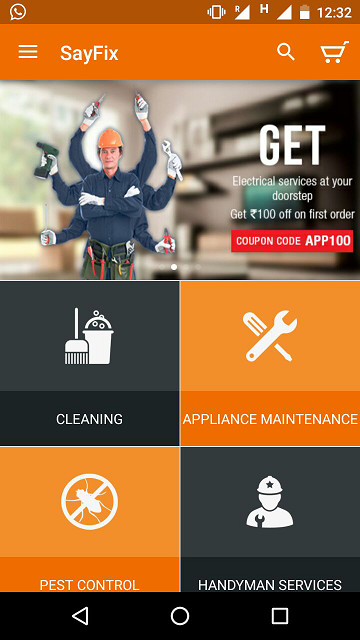Two things teach us valuable lessons: experience and example. This story has both.
It takes great courage to start something new. Even greater to soldier on when the industry gets crowded with heavily funded competition. But what is most courageous of all, is realizing that somewhere you went wrong, being wise enough to accept it, and gracious enough to share your story for everyone to benefit from.

Sayfix was founded way back in 2010; their brand name and tagline describes the best what they do: “Sayfix-and it’s done!”
They were one of the first service-at-your-doorstep providers, way before the Housejoys and the Urbanclaps of the world were born. But, as we all know, they weren’t the only ones to venture into this. Eventually, a much crowded market and a few unfavorable conditions made them halt, rethink and retract.
This is that story.
This is how it began
Sayfix was never intended as a business, originally. Founder Nabin Roy (who already had another venture) started it as a CSR (Corporate Social Responsibility) activity. The intention was to proffer employment to people from Bihar. Four teams of six guys were formed and they began providing tank cleaning services to corporate offices and apartment complexes, all around Bangalore.
The customer satisfaction from their service was so high, that the customers came back repeatedly, and not just for tank cleaning…for more. Requests for other services such as painting, car cleaning and the like, began pouring in.
Come January 2015, they decided that this could become a full-fledged business because the requests kept growing, and the market was getting mature for on-demand services. The fact that players like UrbanClap and HouseJoy had just entered the market with a good reception from the public, were just push points.
The growth phase
Building the team
They first went about building a team to help out with technology and operations and thus ‘Sayfix’ came into existence.
Online presence
Once their services were operational, they were present on three platforms:
- Website
- Mobile App
- Customer Helpline
But unlike their counterparts who went for a web-first model, they decided to try app-first.

Attracting customers
The next step was to attract customers for their businesses. This wasn’t much of a problem; they had been in the market for almost 5 years now. Their old customers effortlessly brought in new business (shows what good service can do). Almost 30-40% of the initial clientele were the old folks. Moreover, these customers began referring them to newer people, thus growing their client base.
The business steadily gained momentum and they continued providing these services on a larger scale than ever before.
The things that worked
As is the norm now, most of the competition bid heavily on keywords and paid traffic, but Sayfix couldn’t keep up. Hence they decided that they needed to adopt a style that was different from the rest (and maybe a little easier on the pocket, too).
Since their sales people already had good contacts with most of the association heads of apartment complexes, they began putting up offline kiosks. These kiosks offered the same services within the complexes, and proved more profitable for them than their online ventures.
They gained good traction and put up 10 more kiosks in selected societies around Bangalore.
But, for Sayfix, this was a considerable short term success.
When the problems began..
Sayfix’s steady growth was occasionally hampered by a few of the many common problems that startups usually face. They began to realize that a majority of their clientele were their old customers placing repetitive orders. The amount of new clients coming in was pretty low. In fact, the new clients were simply a mere 30% of the total client base.
Besides, they began to lose a few customers due to pricing issues, since their clientele were receiving the same services elsewhere, for lesser prices. But this was not a major concern, as they were still doing all right.
Though they found success with offline activities, they began to realize that it wasn’t completely scalable. They began looking for solutions that would help them handle marketing better. But, they never really did find that sweet spot.
What is happening now..
They have significantly scaled back on operations, since March. They now only provide the tank cleaning services they always did, and all other services have more or less been put on hold.
So what went wrong?
Sayfix started out pretty well, but couldn’t carry their success forth. Though they continue fulfilling already placed orders, they do not actively advertise any of their other services.
The reasons they give for this change are:
1. Too much competition in the market
Currently the service commerce industry has become quite crowded, with more than 60 players in the field. Sayfix did not want to become just one among the crowd.
2. Lack of proper marketing channels
They had not gone about setting a strategic marketing plan, which they later regretted as one of their biggest mistakes. They did not, and could not, compete with paid search options that their counterparts were making good use of. Nor did they make much effective use of Social media.
This, Sayfix identifies as one of their shortcomings, which they could have capitalized on. Moreover, they also confess that email campaigns were not effectively made use of. Orders placed were not validated with a confirmation or invoice mail, which led to a load of chaos and dissatisfaction.
3. Lack of a proper Lead Management System
The fact that they were using three different platforms to capture leads meant that a significant amount of data was getting captured in the system. But the data wasn’t consolidated, which led to the problem.
Having no system that would capture leads effectively and effortlessly got them in quite a bind. Below are some of the problems they faced due to this.
- Customers visiting their website were not given the push to place an order (maybe because website visits were not tracked).
- Lead sources remained unidentified, so the intelligence needed to make future decisions wasn’t complete, and this led to a few wrong choices.
- Orders sometimes also got lost in the system due to huge amount of unorganized data.
- There were no nurturing activities in place to encourage future purchases from new visitors.
4. Pushing the app first
Sayfix had gone for an app based approach from the very beginning, which they now term as a bad move from their end. They realized it would have been more prudent to wait and gather customers through their web service, before moving to an app-first model.
The Lesson
Sayfix has now pretty much scaled back to just offer the services they initially started out with. They have gracefully backed out and now focus on what they do best.
But their example is one which reiterates the importance of a strategic marketing plan for any business. An online business, more importantly.
My chat with the Marketing manager at Sayfix assured me that they were still in good spirits, looking forward to more success. And, I am certain that there’s much of it in store for them – after all, they have real experience to drive them further.
(Much thanks to Nanda Kishore, Marketing Head at Sayfix for letting me share their story with the world for everyone to learn from.) :)









